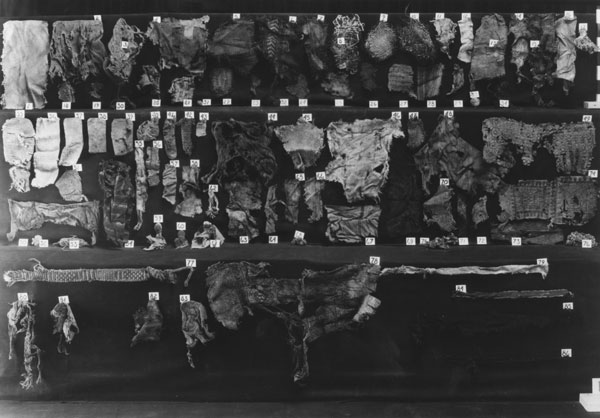™“Textiles are
the first material to touch our skin at birth and what many of us will lay upon
at the moment of death. Textiles are the material that covers our bodies every
day of our lives; the material we rest between each night. It is the textile
that is used to staunch the flow of blood from wounds and protect us against
cold and wind and excessive light. They are quite literally an inescapable
presence, trailing close behind air, water and food in our list of needs and
wants.” Dr Jessica Hemmings
comes from her essay 'A Vivid Vocabulary'
Wikipedia definition of textiles:
- A textile or cloth is a flexible woven material consisting of a network of natural or artificial fibres often referred to as thread or yarn. Yarn is produced by spinning raw fibres of wool, flax, cotton, or other material to produce long strands. Textiles are formed by weaving,knitting, crocheting, knotting, or pressing fibres together (felt).
|
fabric has been a basic part of everyday life from prehistoric times. Fabrics meet a range of purposes, because it is such a 'flexible medium'; it can be wrapped around something tightly or loosely draped over another object; it can be woven to one shape, knitted so it stretches and can move with a person's body, or it can be joined together or with different materials to make new items; e.g. 'rag dolls and tents'.
 |
| From the exhibition: Kelsey Museum archival photo 7.2522, showing examples of textiles found at Karanis. |
- fabric serves practical functions;
- fabric communicates messages and ideas
- fabric has value
- fabric depends upon technology
- which fabrics, and why?
Hemmings mentions our 'needs and wants', this made me think of our human rights and what actually is included in them. So I looked up 'The Universal Declaration of Human Rights' and came across this;
Article 25
- (1) Everyone has the right to a standard of living adequate for the health and well-being of himself and of his family, including food, clothing, housing and medical care and necessary social services, and the right to security in the event of unemployment, sickness, disability, widowhood, old age or other lack of livelihood in circumstances beyond his control.
- (2) Motherhood and childhood are entitled to special care and assistance. All children, whether born in or out of wedlock, shall enjoy the same social protection.
so not only do we want the newest clothes/fabric decorations to keep in with the latest trends/fashion, but it is actually our right to be able to 'adequately' dress ourselves - unless of course you don't want to be clothed, even then you would still come into contact with other materials/fabrics.
But what happens when trends change and people want to get rid of all their 'outdated' or 'unfashionable' fabrics/clothes/materials. Well some people donate their clothes to charities, put them into clothes banks, or re-sell them, but other times they just get thrown away. This website; http://textilewastediversion.com/necessity-is-the-mother-of-all-invention/, talks about the ways in which throwing away textiles is actually harmful to the environment, and how banning textiles from landfills would be beneficial. It also mentions how some EU countries, who already have this landfill textile ban, have had to come up with other 'green' ways to manage the textiles waste, and by using this technology to turn waste textiles into 'sustainable raw materials', which have uses in commercial, industrial and agricultural applications, they have created new jobs.
Do we take fabrics for granted? Could you imagine living without them?? Aside from a lot of people blushing or being afraid to leave their homes, just think of all the things you wouldn't be able to do. No choosing the perfect 'pulling' outfit on a girly night out, no curtains to block the light when you're trying to sleep, no sheets to wrap up in when you're cold or feeling ill, no more beautiful decorations to brighten up your home, no way to express yourself without words...... the list goes on and on!!! On the up side you would save a hell of a lot of money not buying clothes... and shoes ;)
No comments:
Post a Comment